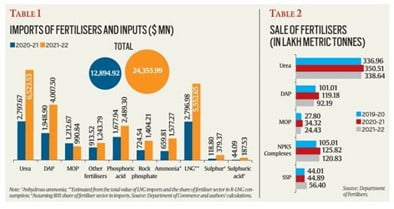Economics, Governance
Context: No country has as much area under farming as India. But there’s one resource in which the country is short and heavily import-dependent — mineral fertilizers.
- In 2021-22, India imported 10.16 million tonnes (mt) of urea, 5.86 mt of di-ammonium phosphate (DAP) and 2.91 mt of muriate of potash (MOP). In value terms, imports of all fertilisers touched an all-time high of $12.77 billion last fiscal.
- In 2021-22, India also produced 25.07 mt of urea, 4.22 mt of DAP, 8.33 mt of complex fertilisers (containing nitrogen-N, phosphorus-P, potassium-K and sulphur-S in different ratios) and 5.33 mt of single super phosphate (SSP). The intermediates or raw materials for the manufacture of these fertilisers were substantially imported.

Table 1: Import of fertilisers and inputs ($MN); Table 2: Sale of fertilisers (in lakh metric tonnes)
Table 1 shows the total value of fertiliser imports by India, inclusive of inputs used in domestic production
- A whopping $24.3 billion in 2021-22.
- There are two costs here.
- The first is foreign exchange outgo
- The second cost is fiscal: Fertilisers are not only imported, but Indian farmers also pay below what it costs to import or manufacture using imported inputs. The difference is paid as a subsidy by the government.
- That bill was Rs 1,53,658.11 crore or $20.6 billion in 2021-22 and projected at Rs 2,50,000 crore ($32 billion) this fiscal.
Both costs are unsustainably high to bear for a mineral resource-poor country.
The Way Forward
- There is a need to cap or even reduce consumption of high-analysis fertilisers – particularly urea (46 per cent N content), DAP (18 per cent N and 46 per cent P) and MOP (60 per cent).
- One way to do this is by incorporating urease and nitrification inhibition compounds in urea.
- These are basically chemicals that slow down the rate at which urea is hydrolysed (resulting in the production of ammonia gas and its release into the atmosphere) and nitrified (leading to below-ground loss of nitrogen through leaching).
- By reducing ammonia volatilisation and nitrate leaching, more nitrogen is made available to the crop, enabling farmers to harvest the same, if not better, yields with a lesser number of urea bags.
- Together with products such as liquid “nano urea” – their ultra-small particle size is conducive to easier absorption by the plants than with bulk fertilisers, translating into higher nitrogen use efficiency – it is possible to achieve a 20 per cent or more drop in urea consumption from the present 34-35 mt levels.
- A second route is by promoting sales of SSP (containing 16 per cent P and 11 per cent S) and complex fertilisers such as “20:20:0:13” and “10:26:26”.
- DAP use should be restricted mainly to paddy and wheat; other crops don’t require fertilisers with high P content.
- India can also import more rock phosphate to make SSP directly or it can be converted into “weak” phosphoric acid.
- India needs to wean its farmers away from all high-analysis fertilisers: That movement requires a concerted push, alongside popularising high nutrient use-efficient water-soluble fertilisers (potassium nitrate, potassium sulphate, calcium nitrate, etc) and exploiting alternative indigenous sources (for example, potash derived from molasses-based distillery spent-wash and from seaweed extract).
- Knowledge Building of Farmers: No plan to cap/reduce consumption of high-analysis fertilisers can succeed without farmers knowing what is a suitable substitute for DAP and which NPK complex or organic manure can bring down their urea application. It calls for agriculture departments and universities not just revisiting their existing crop-wise nutrient application recommendations, but disseminating this information to farmers on a campaign mode.
Must Read:
Reforming the Fertilizer Sector
Locational factors of fertiliser industry
Source: The Indian Express














